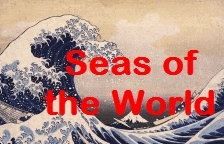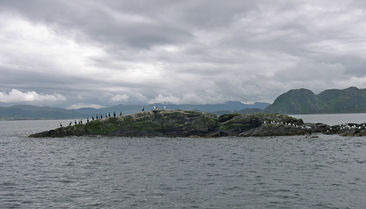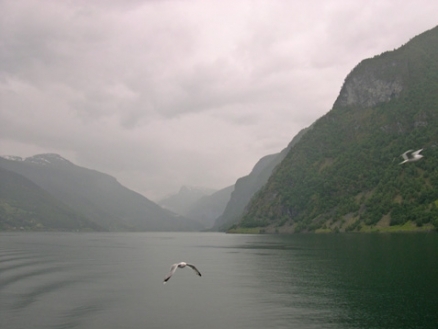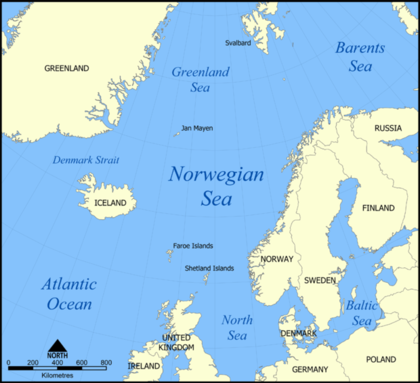Norwegian
Contents
Norwegian Sea
Seas of the World  The Norwegian Sea is a saline marginal sea, and an element of the North Atlantic Ocean, situated west of Norway. This sea is characterised by its cold deep basins that are relatively isolated by sills from Greenland and Scotland. It is located between the North Sea (i.e. northeast of Scotland) and the Greenland Sea, and adjoins the North Atlantic in the west and the Barents Sea at its northeast. At the southwest, the Norwegian Sea is divided from the Atlantic Ocean by a major submarine ridge that extends between the nation island of Iceland and the Faroe Islands. At the northwest of the Norwegian Sea, the Jan Mayen Ridge separates the Norwegian Sea from the Greenland Sea.
The Norwegian Sea is a saline marginal sea, and an element of the North Atlantic Ocean, situated west of Norway. This sea is characterised by its cold deep basins that are relatively isolated by sills from Greenland and Scotland. It is located between the North Sea (i.e. northeast of Scotland) and the Greenland Sea, and adjoins the North Atlantic in the west and the Barents Sea at its northeast. At the southwest, the Norwegian Sea is divided from the Atlantic Ocean by a major submarine ridge that extends between the nation island of Iceland and the Faroe Islands. At the northwest of the Norwegian Sea, the Jan Mayen Ridge separates the Norwegian Sea from the Greenland Sea.
The series of perimeter sills has isolated the Norwegian Sea from effective invasion of many North Atlantic marine fauna and promoted a relatively high level of endemism in this highly saline sea.
The Norwegian Sea was a key northern route for the Norwegian Vikings, providing an avenue south for raids and sea trading. These routes became active in about the ninth century AD, when the Norwegian Sea and Baltic Sea became more ice free, and yet Scandinavian nations populations were expanding and suffered from a paucity of arable land.
Circulation and Hydrology
The gross circulation of the Norwegian Sea is characterized by water influx from the North Atlantic at the Svinoy Section and effluxes through the Barents Sea opening and the Sorrkap Section. Drivers of the magnitude of the influx and efflux of ocean currents within the Norwegian Sea are chiefly atmospheric in nature, explaining the great variation in the size of these fluxes. The Great Salinity Anomaly arrived at the Norwegian Sea slightly later (late 1970s) than most other far northern seas, due to the anti-clockwise propagation of that salinity depression.
Characteristic depths of the Norwegian Sea are in the range of one to two kilometres, much deeper than other seas at the south of the region, such as the North Sea. Significant sills separate the North Sea and the North Atlantic from the Norwegian Sea.
As recent as the late Cretaceous period (~100 - 66 million years ago), the Norwegian Sea had a temperate environment with ocean temperatures ranging from 10 to 17 degrees Celsius. In the Pleistocene era (~2.6 million to 12,000 year ago) there was a large scale anti-clockwise gyre that persisted stably over a very long-term time interval; astoundingly, that persistent gyre seemed to survice the vicissitudes of glacial advance and melt. During peak glaciation, basal tills were deposited on the shelf, but interglcials, typical distal glacial marine deposition prevailed. However, that gyre pattern not only broke down abrubtly in the early Holocene (which began ~12,000 before the present) with massive melting of Arctic ice, but the Holocene pattern appears to have shifted even within the last five thousand years, by examining Bischof's ice raft analysis. These Holocene vacillations in current pattern augur for the notion that man's impact on climate began thousands of years ago, probably with the massive deforestation and accompanying grazing that accompanied his rise to planetary dominance beginning in the early Holocene.
Ecology
 Coastal skerry near Alesund, Norway. @ C.Michael Hogan
Coastal skerry near Alesund, Norway. @ C.Michael Hogan
The Norwegian Sea is important for the Atlantic salmon population as well as the cod population. About one third of Atlantic salmon spawn in the coastal rivers and fjords of Norway; salmon have vanished from 45 of these freshwater discharges, a phenomenon believed to be caused by overfishing, acid rain accumulation, infestation by Gyrodactylus salaris (small, leech-like parasite), terrestrial runoff of agricultural nutrients and discharges from aquaculture. In addition to the adverse discharges from aquaculture, there is strong concern regarding Genetic pollution from admixture of cultured cod and salmon to the wild populations of those species. Birds frequenting the Norwegian Sea include Eider-ducks (Somateria mollissima), Guillemots (Uria aalge), Little auks (Alle alle) and gulls.
Generally, as for all parts of the North Atlantic, species diversity of marine megafauna and meiofauna is lower than average for the [[sea]s of the world]. An example copepod in the Norwegian Sea is Calanus finmarchicus, which is present here in massive concentrations; this zooplankter is rich in protein, omega-3 fatty acids and antioxidants, so that it is being pursued as a marine feed.
The sill induced isolation of the deep basin Norwegian Sea has generated significant endemism. More properly much of the endemism should be assigned to the Arctic basin, which shares significant connected depths, high salinity and cold temperatures. Most endemism occurs at the species level with a notable exception of the genus level endemic Lipariid fish Rhodichthys regina.
Viking Era
The Vikings were the first to systematically exploit the Norwegian Sea, continuing south to the North Sea. Sea of the Hebrides and Irish Sea for their trading and raiding. While best known for the pillaging aspect of their lifestyles, the Vikings were efficient in conveying furs, timber, walrus ivory and other goods to gain revenue; furthermore, as Graham-Campbell observes, the Arab world had a high apetite to obtain more slaves, for whom they paid the Vikings handsomely in silver. The Viking trading network was complex and had to address not only risky sea navigation, but also contend with trade barriers, such as those established by British Christian merchants.
References
- Jens Bischof. 2000. Ice drift, ocean circulation, and climate change. (Google eBook). Springer. 215 pages
- Erik Dahl. 1972. The Norwegian Sea deep water fauna and its derivation. Ambio Special Report. Allen Press
- Robert R. Dickson. 2008. Arctic-subarctic ocean fluxes: defining the role of the northern seas in climate. Springer. 736 pages
- James Graham-Campbell. 2001. The Viking world. Frances Lincoln Ltd. 220 pages
- Kenneth Henry Mann, J.R.N.Lazier. 2006. Dynamics of marine ecosystems: biological-physical interactions in the oceans (Google eBook) Wiley-Blackwell. 496 pages
- Ritzrau Andrea Schroeder et al. 2001. Distribution, export and alteration of plankton in the Norwegian Sea Fossiliziable in: Priska Schaefer: The Northern North Atlantic: A Changing Environment, Springer
- A.Solheim, P.Bryn, K.Berg, H.P.Sejrup, J.Mienert. 2005. Ormen Lange: an integrated study for safe field development in the Storegga submarine slide area. Gulf Professional Publishing. 326 pages
- Universitetsforlaget. 1971. The Norwegian Sea region: its hydrography, glacial and biological history. Symposium at Kristineberg, Sweden, 29-30 March, 1971
- Organisation for Economic Co-operation and Development. 2010. Advancing the Aquaculture Agenda: Workshop Proceedings (Google eBook) OECD Publishing. 428 pages
- George Goudie Chisholm ed. 1916. Longmans' gazetteer of the world. Longmans. 1788 pages

